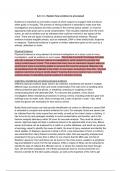A.C.1.3 - Explain how evidence is processed
Evidence is important as it provides a basis of which suspect is charged, tried and found
either guilty or not-guilty. The process of storing evidence is essential to make sure that
investigations and suspects are tried correctly in the criminal justice system, so must be
approached with great care to avoid contamination. This includes materials from the crime
scene, as well as exhibits such as witnesses that could be involved in any aspect of the
crime. There are two types of evidence; physical and testimonial evidence. Physical
evidence includes tangible articles, such as materials, DNA or other bodily fluids, footprints
or weapons. Testimonial evidence is spoken or written statements given to the court by a
witness, defendant or victim.
Physical Evidence
Physical Evidence is a key element of criminal investigations as it plays a part in every
investigation, used as evidence in court cases. This is due to Locard’s Exchange Principle,
who was a pioneer in forensic science in investigations, which details the principle that
“every contact leaves a trace.” This means that every time an interaction happens within an
environment, there is something added or removed that could be analysed. Materials may
be transferred from the offender to the victim, or vice versa. According to Paul Kirk, “physical
evidence cannot be wrong or wholly absent” meaning that every instance has a concrete
evidence base of undeniably physical evidence if extracted correctly.
Collecting, transferring and storing physical evidence
Different physical evidence types need to be collected, transferred and stored in multiple
different ways to preserve them and avoid contamination.The main error is handling items
without protective gear like gloves, or breathing, sneezing or coughing on them,
contaminating them with alternate DNA. To overcome this problem, Crime Scene
Investigators follow mandatory procedures in serious crimes, including protective gear and
clothings such as mask, suits, shoe coverings and 2 pairs of gloves in case 1 rips, while
mask and gloves are necessary for less serious crimes.
Bodily fluids and tissues can help provide identification of victims or offenders in cases DNA
is extracted to compare and cement evidence for court. For example, blood and semen can
be collected from the crime scene floor and walls, as well as the victim’s body or clothing. It
has to be air dry and packaged carefully to avoid contamination and transfer, sent to the
forensic analysis laboratory within 24 hours for accurate analysis. They must be stored in
secure, tight-lock bags and kept in evidence lockers to be apprehended at any time. Blood,
semen and saliva can be analysed for a match in a police database, and blood can produce
a toxicology report to identify the cause of death, the level of injury sustained and identify the
blood splatter. In Stephen Lawrence’s retrial in 2012, a tiny blood stain (0.5mm x 0.25mm)
was extracted from Gary Dobson’s bomber jacket’s collar, that was expertly analysed and
presented in the jury as less than a billion to one chance that the DNA was not that of
Stephen Lawrence. Hair and fibres can be found on the crime scene, sealed in a polythene
bag and labelled to send it for the lab analysis. DNA or origins of fibres can be extracted to
identify the type of material the offender can be, or where the material has been through
dust, dirt and other substances. All of these procedures have to involve personnel of a
forensic scientist for the best quality analysis, as well as the expertise of the CSI to get




